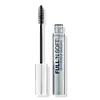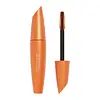What's inside
What's inside
 Key Ingredients
Key Ingredients

 Benefits
Benefits

 Concerns
Concerns

 Ingredients Side-by-side
Ingredients Side-by-side

Petroleum Distillates
SolventC8-9 Isoparaffin
SolventDisteardimonium Hectorite
StabilisingBeeswax
Emulsion StabilisingCopernicia Cerifera Wax
Water
Skin ConditioningSynthetic Beeswax
Emulsion StabilisingAllyl Stearate/Va Copolymer
Paraffin
PerfumingPropylene Carbonate
SolventPolyvinyl Laurate
Silica
AbrasiveOryza Sativa Starch
AbsorbentPanthenol
Skin ConditioningHydrolyzed Corn Starch
HumectantMethylparaben
PreservativeIsoceteth-20
EmulsifyingLecithin
EmollientAcrylates Copolymer
Ethylene/Methacrylate Copolymer
Tocopheryl Acetate
AntioxidantDisodium EDTA
Disodium Cocoamphodiacetate
CleansingOleamide
2-Oleamido-1,3-Octadecanediol
Skin ConditioningSimethicone
EmollientDiazolidinyl Urea
PreservativePropylparaben
PreservativeCI 77492
Cosmetic ColorantCI 77499
Cosmetic ColorantCI 77491
Cosmetic ColorantCI 75470
Cosmetic ColorantCI 77007
Cosmetic ColorantCI 77288
Cosmetic ColorantCI 77289
Cosmetic ColorantMica
Cosmetic ColorantCI 77891
Cosmetic ColorantCI 77510
Cosmetic ColorantPetroleum Distillates, C8-9 Isoparaffin, Disteardimonium Hectorite, Beeswax, Copernicia Cerifera Wax, Water, Synthetic Beeswax, Allyl Stearate/Va Copolymer, Paraffin, Propylene Carbonate, Polyvinyl Laurate, Silica, Oryza Sativa Starch, Panthenol, Hydrolyzed Corn Starch, Methylparaben, Isoceteth-20, Lecithin, Acrylates Copolymer, Ethylene/Methacrylate Copolymer, Tocopheryl Acetate, Disodium EDTA, Disodium Cocoamphodiacetate, Oleamide, 2-Oleamido-1,3-Octadecanediol, Simethicone, Diazolidinyl Urea, Propylparaben, CI 77492, CI 77499, CI 77491, CI 75470, CI 77007, CI 77288, CI 77289, Mica, CI 77891, CI 77510
Water
Skin ConditioningGlyceryl Stearate
EmollientAmmonium Acrylates Copolymer
Disteardimonium Hectorite
StabilisingPropylene Glycol
HumectantStearic Acid
CleansingCopernicia Cerifera Wax
Triethanolamine
BufferingAcrylates Copolymer
Synthetic Wax
AbrasivePolyvinyl Alcohol
Lecithin
EmollientPropylene Carbonate
SolventPolyethylene
AbrasiveOleic Acid
EmollientAlcohol Denat.
AntimicrobialBenzyl Alcohol
PerfumingGlycerin
HumectantXanthan Gum
EmulsifyingPanthenol
Skin ConditioningPhenoxyethanol
PreservativePropylparaben
PreservativeMethylparaben
PreservativeEthylparaben
PreservativeSodium Laureth Sulfate
CleansingTrisodium EDTA
Simethicone
EmollientTocopheryl Acetate
AntioxidantTocopherol
AntioxidantIron Oxides
Titanium Dioxide
Cosmetic ColorantUltramarines
Water, Glyceryl Stearate, Ammonium Acrylates Copolymer, Disteardimonium Hectorite, Propylene Glycol, Stearic Acid, Copernicia Cerifera Wax, Triethanolamine, Acrylates Copolymer, Synthetic Wax, Polyvinyl Alcohol, Lecithin, Propylene Carbonate, Polyethylene, Oleic Acid, Alcohol Denat., Benzyl Alcohol, Glycerin, Xanthan Gum, Panthenol, Phenoxyethanol, Propylparaben, Methylparaben, Ethylparaben, Sodium Laureth Sulfate, Trisodium EDTA, Simethicone, Tocopheryl Acetate, Tocopherol, Iron Oxides, Titanium Dioxide, Ultramarines
 Reviews
Reviews

Ingredients Explained
These ingredients are found in both products.
Ingredients higher up in an ingredient list are typically present in a larger amount.
Acrylates Copolymer is used as a film-forming agent and texture enhancer.
After applied, Acrylates Copolymer forms a thin film cover that helps skin feel more soft. It can help sunscreens become more water-resistant.
It is also used to make a product more thick.
Learn more about Acrylates CopolymerCopernicia Cerifera Wax comes from a palm tree native to Brazil; another name for this ingredient is Carnauba Wax.
This ingredient is used to thicken texture and also leaves behind a film when applied.
Fun fact: This wax has the highest melting point of all natural waxes and low solubility.
Learn more about Copernicia Cerifera WaxDisteardimonium Hectorite comes from the clay mineral named hectorite. It is used to add thickness to a product.
It can also help stabilize a product by helping to disperse other ingredients.
Hectorite is a rare, white clay mineral.
Learn more about Disteardimonium HectoriteLecithin is a term for a group of substances found in the cell membranes of plants, animals, and humans. They are made up of mixture of phospholipids.
This ingredient has emollient and emulsifying properties.
As an emollient, lecithen helps soften the skin and creates a barrier to keep moisture in.
As an emulsifier, it also helps prevent water and oil ingredients from separating. Lecithin can also help ingredients be better absorbed by the skin.
This is because the phospholipids in lecithin produce liposomes. Liposomes help other ingredients get through the skin barrier.
Depending on the source of this ingredient, lecithin may not be fungal acne safe. This is because some sources of lecithin come from soybean oil, which may feed the malassezia yeast that feeds fungal acne.
We recommend reaching out to the brand you are purchasing from to inquire about the source of their lecithin.
Some other names for this ingredient include soy lecithin and deoiled soy lecithin.
Learn more about LecithinMethylparaben is a preservative and is a paraben. It is used to prevent the growth of fungus, mold, and other harmful bacteria. Parabens are chemicals used as preservatives in both cosmetics and food.
Methylparaben can be synthetically created. It can also be found naturally in some fruits, such as blueberries.
Oftentimes, Methylparaben is combined with other parabens to help increase the shelf life.
The safety of Methylparaben is currently being studied. While ongoing studies are looking into the safety of parabens, the results have been very mixed. Some studies have not found Methylparaben to be harmful.
Learn more about MethylparabenPanthenol is a common ingredient that helps hydrate and soothe the skin. It is found naturally in our skin and hair.
There are two forms of panthenol: D and L.
D-panthenol is also known as dexpanthenol. Most cosmetics use dexpanthenol or a mixture of D and L-panthenol.
Panthenol is famous due to its ability to go deeper into the skin's layers. Using this ingredient has numerous pros (and no cons):
Like hyaluronic acid, panthenol is a humectant. Humectants are able to bind and hold large amounts of water to keep skin hydrated.
This ingredient works well for wound healing. It works by increasing tissue in the wound and helps close open wounds.
Once oxidized, panthenol converts to pantothenic acid. Panthothenic acid is found in all living cells.
This ingredient is also referred to as pro-vitamin B5.
Learn more about PanthenolThis ingredient is a solvent. It helps dissolve active ingredients and alter the texture of products.
Propylene Carbonate is commonly used in makeup and with clay, such as montmorillonite or bentonite.
Studies show this ingredient to be safe for cosmetics. When it is undiluted, it can cause skin irritation. (It is always diluted in skincare and makeup). This ingredient is water-soluble.
Propylene Carbonate is created from propylene glycol and carbonic acid.
Learn more about Propylene CarbonatePropylparaben is a preservative and is a paraben with antifungal and antimicrobial properties.
This ingredient can be naturally found in plants and insects, but most of it is synthetically manufactured for human use. In cosmetics, it is usually created by reacting para-aminobenzoic acid and propanol (an alcohol).
You can usually find this ingredient in water-based products.
Parabens have come under controversy due to the claim they are hormone disruptors. Studies show conflicting results. We recommend speaking with a professional if you have any concerns.
Propylparaben is commonly found in food, medicine, and cosmetics.
Learn more about PropylparabenSimethicone is a silicone. It is an emollient and used to reduce foaming in a product. It is also often used to coat sunscreen ingredients for better spreadability.
This ingredient is created by mixing dimethylpolysiloxane and hydrated silica.
Tocopheryl Acetate is AKA Vitamin E. It is an antioxidant and protects your skin from free radicals. Free radicals damage the skin by breaking down collagen.
One study found using Tocopheryl Acetate with Vitamin C decreased the number of sunburned cells.
Tocopheryl Acetate is commonly found in both skincare and dietary supplements.
Learn more about Tocopheryl AcetateWater. It's the most common cosmetic ingredient of all. You'll usually see it at the top of ingredient lists, meaning that it makes up the largest part of the product.
So why is it so popular? Water most often acts as a solvent - this means that it helps dissolve other ingredients into the formulation.
You'll also recognize water as that liquid we all need to stay alive. If you see this, drink a glass of water. Stay hydrated!
Learn more about Water